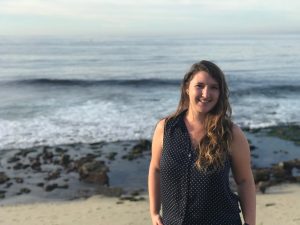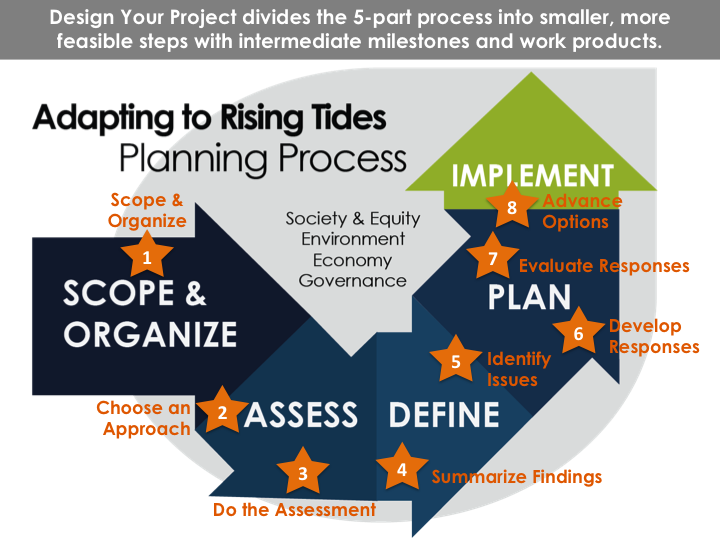I wasn’t planning to lead.
I was standing in the back and then everyone turned around. – Avery Hiebert
Leading your own adaptation planning project is a daunting task. The ART Program staff know this firsthand. Beginning in 2010 with the Alameda County Project, ART Program staff have led, supported and collaborated on more than ten different planning efforts around San Francisco Bay that range in scope and scale. Through this work, we have learned a great deal about how to design and conduct an adaptation planning process that is effective and efficient, and appropriate to the needs of project partners and available resources.
Now we want to put all of this knowledge and experience to further good use by helping you with your planning efforts. The ART Program team is available to answer questions, to help and support efforts, and to brainstorm with you about how to approach resilience planning within your community, jurisdiction, organization or agency.
- The bios for our program staff can help to lead you to the staff member(s) most familiar with your topics of concern. Or, feel free to contact any of us and we will connect you with the right support.
- The ART Approach page describes the planning process that the ART Program has developed, tested and refined in past projects, and that we continue to use and build upon.
- Our Definitions and FAQs can help answer questions that we commonly get about the ART approach and the Portfolio resources.
Who’s here to help?
Dana Brechwald
 Dana joined BCDC as the Adapting to Rising Tides Program Manager in November 2018. Dana holds a Bachelor of Arts degree in Architecture from the University of California, Berkeley and a Master of City Planning from Harvard, where she focused on community disaster recovery and climate adaptation planning. Prior joining BCDC, Dana was a Regional Resilience Planner for several years at the Association of Bay Area Governments and Metropolitan Transportation Commission, where she led projects focused on regional and local multi-hazard vulnerability assessment and strategy development, including earthquakes, sea level rise, and wildfire. She co-led the Stronger Housing, Safer Communities project with BCDC as well as the Regional Resilience Framework with EPA and FEMA. Prior to ABAG/MTC, she worked as a sustainability consultant in San Francisco, focusing on developing sustainability rating systems and greenhouse gas reductions projects around the world.
Dana joined BCDC as the Adapting to Rising Tides Program Manager in November 2018. Dana holds a Bachelor of Arts degree in Architecture from the University of California, Berkeley and a Master of City Planning from Harvard, where she focused on community disaster recovery and climate adaptation planning. Prior joining BCDC, Dana was a Regional Resilience Planner for several years at the Association of Bay Area Governments and Metropolitan Transportation Commission, where she led projects focused on regional and local multi-hazard vulnerability assessment and strategy development, including earthquakes, sea level rise, and wildfire. She co-led the Stronger Housing, Safer Communities project with BCDC as well as the Regional Resilience Framework with EPA and FEMA. Prior to ABAG/MTC, she worked as a sustainability consultant in San Francisco, focusing on developing sustainability rating systems and greenhouse gas reductions projects around the world.
Areas of expertise:
- Regional adaptation planning
- Cross-disciplinary communication of research, findings, and implications
- Communicating about impacts, issues and options
- Summarizing vulnerabilities and consequences and defining planning issues
Todd Hallenbeck
 Todd Hallenbeck joined the ART team in 2017. Todd holds a Bachelor’s of Science in Marine Science from the University of California, Santa Cruz and a Master’s of Science in Coastal Watershed Science and Policy from California State University, Monterey Bay. His research includes seafloor mapping, benthic ecology, and the application of geospatial science to coastal resource management. Prior to joining BCDC, Todd worked as a fellow with Oregon’s Coastal Management Program supporting the state’s planning process for ocean renewable energy and developing a West Coast geospatial data portal to inform coastal management and planning. Todd lives in Alameda and enjoys sailing on the San Francisco Bay.
Todd Hallenbeck joined the ART team in 2017. Todd holds a Bachelor’s of Science in Marine Science from the University of California, Santa Cruz and a Master’s of Science in Coastal Watershed Science and Policy from California State University, Monterey Bay. His research includes seafloor mapping, benthic ecology, and the application of geospatial science to coastal resource management. Prior to joining BCDC, Todd worked as a fellow with Oregon’s Coastal Management Program supporting the state’s planning process for ocean renewable energy and developing a West Coast geospatial data portal to inform coastal management and planning. Todd lives in Alameda and enjoys sailing on the San Francisco Bay.
Areas of Expertise:
- Geospatial analysis and application development
- Remote sensing
- Coastal resource management and planning
Jaclyn Mandoske

Jaclyn joined the ART team in 2018. Jaclyn holds a bachelor’s degree in Aquatic Biology and minor in Professional Writing and Multimedia Communication from the University of California, Santa Barbara, and a master’s degree in Marine Biodiversity and Conservation from Scripps Institution of Oceanography at the University of California, San Diego. Her masters thesis included a spatial and economic analysis of coastal blue carbon habitats in the Bahamas and communication of ecosystem services to inform sustainable development planning for small island governments. She has worked as a science writer and researcher for two international marine conservation nonprofits, as well as in local government, specializing in sustainability, ecology, coastal marine policy, and science communications and graphic design. She is passionate about facilitating collaboration and the transfer of knowledge across people and sectors for effective change.
Areas of expertise:
- Ecosystem services analysis
- Marine ecology
- Communications and graphic design
- Climate adaptation planning
Daniel Hossfeld
Areas of Expertise:
- Scientific Synthesis and Writing
- Aquatic and Marine Ecology
- Natural Shoreline Adaptation
Viktoria Kuehn
Viktoria joined the ART team in 2021 after completing her CA Sea Grant Fellowship with BCDC’s Sediment Management Program. She holds a Bachelor of Science in Biology from Loyola Marymount University and a Master of Science in Environmental Management from University of San Francisco. She has research experience in wetland and subtidal ecology and in the application of geospatial science to identifying suitable habitat for conservation or restoration. Viktoria also has experience in applied aquatic environmental science through her work in consulting, where she conducted field work, authored resource sections for CEQA documents, developed maps, conducted geospatial analysis, and completed permit applications for resource agencies. In her free time, Viktoria enjoys spending time in, on, and next to the water; when that’s too much effort, she enjoys dabbling in art.
Areas of Expertise:
- Aquatic resources (ecology and special-status species)
- GIS analysis and visualization
- Sediment management
Definitions
- Adaptation
The IPCC definition: Adjustment in natural or human systems in response to actual or expected climatic stimuli or their effects, which moderates harm or exploits beneficial opportunities. IPCC Fourth Assessment Report (2007)
The ART Program interpretation: Adaptation responses reduce the vulnerability of natural systems and human communities to existing or predicted climate change impacts. Adaptation can benefit communities by addressing immediate or ongoing issues, while protecting lives, health, property, and ecosystems in the future.
- Resilience
The IPCC definition: The ability of a social or ecological system to absorb disturbances while retaining the same basic structure and ways of functioning, the capacity for self-organisation, and the capacity to adapt to stress and change. IPCC Fourth Assessment Report (2007)
The ART Program interpretation: Resilience reflects the ability of a community to “bounce back” after hazardous events, such as coastal storms and flooding, rather than simply reacting to impacts. In the ART Program, resilience is an overarching goal for adaptation planning outcomes. (Modified from the NOAA National Ocean Service)
- Sustainability
Resilience is underpinned by sustainability which reflects the capacity of human communities to meet their current needs without compromising other species and future generations. A core aspect of the ART approach to adaptation planning is consideration of the relevance and implications of all aspects of sustainability in each step of the planning process, from who is included in the initial working group list to what evaluation criteria are selected to evaluate adaptation responses. ART frames the components of sustainability as, Society and Equity, Economy, Environment and Governance, and defines these in the context of adaptation to climate change as:
FAQs
Can the ART Approach only be used for sea level rise?
Do I need an army of planners in my project team to do this?
How is the Design Your Project guidance different from all the other guidance documents out there?
Why is a collaborative approach important for adaptation planning?
What is the difference between stakeholder engagement and public outreach?
Is the ART approach suited for some situations better than others?
How do the 8 Design Your Project steps fit into the ART planning process?
How do the Design Your Project steps compare in terms of time and level of effort?
- Can the ART Approach only be used for sea level rise?
The emphasis of the ART approach on a collaborative and transparent planning process, that integrates sustainability throughout is important for successful outcomes for any/all types of planning projects and processes. Many of the ART projects have included issues beyond sea level rise, such as seismic and current flooding. Additionally, many of the How-To > Design Your Project steps and ART Supplies are applicable for a broad range of issues, including climate and hazard resilience. However, the guides and supporting information related to exposure analysis are specific to current and future flood scenarios. The guidance in Design Your Project can help you with the process for selecting impacts and scenarios and conducting exposure analyses for other types of climate impacts, such as heat and drought, but not the specifics for these issues.
- Do I need an army of planners in my project team to do this?
It is important when designing your process (How-To > Design Your Project > 1. Scope & Organize) to consider the size, capacity and availability of your project team, consultant support as well as working group interest and capacity in contributing to the effort. An additional consideration is the availability of existing studies or efforts that can contribute to the assessment and make it easier and more efficient to conduct the study or convene the working group.
Be creative and strategic when considering who to include on your planning team. For example the ART project team joined efforts with a project team from another agency that was working on hazard mitigation planning. The two teams were able to work closely together and extend the resources and capacity beyond what each of them had separately and made it easier for their stakeholders to participate in a joint effort rather than having to engage in two separate efforts.
With all of those factors in mind, it is critical that there be at least one person dedicated to managing the project and moving it forward and, ideally, one or two team members who can conduct the research and writing, and help with engagement exercises. Expanding that team with consultants, working group members and other agency partners is a great way to be able to conduct a more robust assessment.
Scaling your effort to the availability and capacity of your team will be an important part selecting your assessment approach, and communicating and agreeing on that approach with your working group members (How-To > Design Your Project > 2. Choose an Approach) For example, your working group may want to conduct a thorough assessment of every component of their city’s storm water and drainage system. However, you may not have the data or staff to conduct this type of assessment, and will need to present the alternatives to your working group and describe how the effort could either be phased or capacity expanded for later work, but under current resources, only a portion of the assessment can be conducted.
Using the ART approach will allow you to scale the project up or down to reflect the level of detail and geographic scale that your project will be conducting and will allow you to expand later if resources or information becomes available.
- How is the Design Your Project guidance different from all the other guidance documents out there?
The ART approach is different from other guidance approaches and documents in several ways.
- The first is that the ART Program team has used the ART approach repeatedly at different scales, for different types of assets and with working group members representing a wide variety of agencies, sectors and interests. Through these varied processes and efforts, we have refined every step in the planning process based on feedback and recommendations of our working group members from ART Program projects. The ART approach has been developed with, and tested by, city planners, flood managers, transportation planners and engineers, wastewater treatment operators, natural resource managers, park managers and operators, community groups, facilities managers, airport and seaport planners and operators and others.
- Another way that the ART approach is different from other guidance approaches is the Define step, which avoids the controversial and unnecessary ranking and rating of assets and vulnerabilities that is often part of other such efforts. The Define step ensures that your process results in vulnerabilities that have been categorized and organized in a way that will allow your working group, community members and decision makers to make informed and transparent decisions toward implementation and prioritization. Learn more about the Define step in the ART Approach White Paper (
 )
) - The third way the ART approach is different from other guidance is the amount of support the ART Program team is providing through example process agendas, engagement exercises, how-to guides, assessment questions, findings from previous projects and our Help Desk for providing guidance and support to those who contact us.
The last way the ART approach is a bit different from other efforts is the design of the approach to incorporate the four frames of sustainability throughout the process from scoping and resilience goals to assessment questions, to the Define step and the use of evaluation criteria to weigh adaptation and implementation options.
By incorporating society and equity, economy, environment and governance throughout the process, the outcomes have these issues embedded – or baked – into them from the beginning and are not just tacked on to the end or focused on one or two of these issues at the expense of the others.
- Why is a collaborative approach important for adaptation planning?
A key benefit of good stakeholder engagement is the development of strong inter-organizational relationships that can serve as the foundation for collaborative problem solving. This type of collaboration is essential for resolving the complex planning issues raised in adapting to climate change. Specifically, new and strengthened relationships can lead to successful knowledge sharing, coordination and cooperation among organizations that can support issue identification, prioritization, expanded funding opportunities and adaptation implementation.
Although a less inclusive or collaborative process may be faster and easier to lead, ultimately this will limit the ability of project participants to reach a comprehensive understanding of the complex issues that extend beyond a single jurisdiction, agency or sector, and to build adaptation responses that take into account all aspects of sustainability, geographic scale, jurisdiction, and timing. If project resources are too limited for a collaborative planning effort, there may still be value to conducting a single sector or single-issue assessment with the intention of using this to build towards more complex and integrated assessments.
Learn more about the important role of stakeholder engagement in the ART approach to adaptation planning: Good Planning Guide: Stakeholder Engagement (![]() )
)
- What is the difference between stakeholder engagement and public outreach?
The ART approach to adaptation planning relies on the project team working closely – engaging – with a group of stakeholders who actively participate throughout the project. With the help of these working group members, the project team can also reach out to and communicate with a broader group of stakeholders. The graphic (below) lays out these project roles and responsibilities.
In the ART approach, “other stakeholders” could be members of the public or elected officials or organizations and individuals who were not part of the working group but who have a role in the effort. Who they are depends entirely on the needs of the project. For example, they might be staff in other departments or divisions within one agency, community organizations and industry groups, land owners or individual community members within the project area. While the ART approach defines this as stakeholder engagement, it could also be defined as public outreach. If there is a distinction to be made between the two, it would be this; public outreach should be designed to both educate and empower those with little knowledge of the subject to understand the issues and take action. Stakeholder engagement should do the same but at a greater level of detail and specificity. In most adaptation planning projects, stakeholder engagement precedes broad public outreach, building the information and findings to later share with and engage the public. That said, the public is also a stakeholder and all efforts should be designed with that in mind.
Examples of stakeholder engagement:
The Capitol Corridor Passenger Rail Assessment project team used what they learned in the Alameda County ART Project to engage members of the Capitol Corridor Joint Powers Authority (CCJPA) about the issues confronting the region’s rail lines and CCJPA’s services. This stakeholder outreach resulted in the CCJPA Board supporting an effort to conduct a more specific hotspot analysis of passenger rail vulnerabilities.
The City and County of San Francisco began an effort called SF Adapt, developed to coordinate the City’s response to climate change. SF Adapt started with efforts within the San Francisco Public Utilities Commission to develop city-wide, science-base guidance for capital planning. SF Adapt includes a working group of staff members from all of the City’s departments and agencies.
The Alameda County ART Project brought a diverse group of over sixty Federal, State, regional, local, non-governmental groups and others to work together to develop a vulnerability and consequence assessment for Alameda County, to learn and teach each other how to conduct such an effort and to disseminate the process and findings results to a broader group of stakeholders.
Examples of public outreach:
The “What?! Sharks in My Backyard?” series of community discussions about the local impacts of sea level rise developed as an offshoot of Hayward Shoreline Resilience Study. The Hayward Shoreline Interpretive Center did broad outreach to community members for these events.
“Owl Eyes” in Marin County was paid for by the Federal Emergency Management Administration and implemented in Southern Marin along the county’s public pathways along the San Francisco Bay shoreline. The effort included a series of viewing tools to engage members of the public on sea level rise in their community.
Examples of stakeholder engagement and public outreach:
The Southern Marin Sea Level Rise Study led by Marin County Supervisor Kate Sears mixed stakeholder engagement and public outreach at different points of the study. The first part of the study included a steering committee of selected members of the community, and was designed to both educate the steering committee members and learn from them. The effort led to a public outreach meeting that included members of the steering committee educating and engaging members of the public through games and presentations designed by the steering committee.
The City of Benicia’s Vulnerability Assessment and Adaptation Plan included the stakeholder engagement of city departments and divisions, business owners and others in developing the assessment and the plan and included public outreach methods such as a website, an open town hall and public meeting.
- Is the ART approach suited for some situations better than others?
The ART approach was designed to address multiple sectors and incorporate multiple agencies and it is likely best suited for those types of efforts. However, the approach works very well within single cities where a number of agencies, departments and organizations need to be included in an assessment, the development and selection of adaptation and implementation options. The approach is also suited to a single issue or sector approach and has been used for that type of assessment in several projects, such as the ART East Bay Regional Park District project and the Capitol Corridor Rail project.
There are some parts of the guidance that are not necessary when conducting a single issue or sector assessment, but it is not necessary to follow every step and those conducting such assessments are free to use what is helpful or fits within their process. It is important to have a lead project team and either an individual or team who is responsible for implementing the steps and ensuring that the outcomes and products are developed and finalized. If you are still wondering if the ART approach could be used for your effort, contact us (link to help desk) and we can help you determine what parts of the approach are best suited to your effort.
- How do the 8 Design Your Project steps fit into the ART planning process?
- How do the Design Your Project steps compare in terms of time and level of effort?
Step 1. Scope & Organize and Step 2. Choose an Approach: These first steps should result in a strong foundation for your project: clear direction, goals and outcomes, and buy-in and ongoing participation from working group members and others. During this time, your project team, working group and partners build relationships and trust, and determine the communication practices and processes for decision-making. It is also a good idea to familiarize yourself with existing studies, efforts, groups and issues that should be considered and incorporated in designing your project and determining your working group. It is important to be thoughtful and transparent as you move through these steps, and to recognize the value of the work and efforts that have gone before and determine how to incorporate these into your project. There are one or two working group meetings associated with this step. In terms of percentage of effort, approximately 15 percent of your team’s time should be spent on these early steps.
Step 3. Do the Assessment: Conducting the assessment is the most time consuming step due to the amount of research, interviews, meetings, field work and writing that needs completed. The assessment questions must be answered through research of existing studies and documents. Design Your Project provides guidance on where to look to answer these questions. After drafting answers, they must be verified with the appropriate working group members and stakeholders. There are multiple working group meetings and individual agency meetings and field trips associated with this step. In terms of percentage of effort, the assessment step is approximately 30 percent of your team’s time.
Step 4. Summarize Findings, and Step 5. Identify Issues: The amount of time spent on these Define steps depends heavily on the foundation built in the assessment. The more robust your assessment, the more support your project team and working group will have in summarizing findings, identifying the key planning issues and developing outcomes that will be supported by the work conducted in the assessment. This step requires one or two working group meetings: a meeting to present draft findings and issues, and another to present final versions. The project team will also benefit from talking and meeting with some agencies, organizations and stakeholders separately to share and discuss draft profile sheets that have summarized findings and issue statements, and to work on identifying key planning issues. Steps four and five are likely to take approximately 20 percent of your team’s time.
Step 6. Develop Responses: At this point in your project, you should already have a strong foundation of information to support the development of adaptation responses. Additionally, there are a number of resources provided in Design Your Project to help your project team develop draft asset-specific adaptation responses fairly quickly, and refine them with working group members, stakeholders, community members and others. This will enable you to focus your project team’s work with the working group on developing comprehensive solutions for the key planning issues that were identified in the previous step. This step usually involves a meeting with the entire working group to review asset-specific adaptation responses, and help develop responses for key planning issues. Depending on the issues themselves, it is sometimes more efficient to hold smaller issue-specific meetings or field trips with relevant stakeholders. This step will take approximately 20 percent of your team’s time.
Step 7. Evaluate Responses: In the ART approach, adaptation responses are evaluated using criteria developed based on the project’s resilience goals, the findings from the assessment and the feedback received throughout the project. In a way, this means that much of the work that supports this evaluation step has already been done. The bulk of the effort in this step is to identify the trade-offs, opportunities and challenges associated with the different options. This will take one meeting with your working group or could be combined with step six for one meeting for both the responses and the evaluation of the options. Sample evaluation criteria that the team has used in past ART projects are available in Design Your Project. For the ART Program, this step has taken about 10 percent of the team’s time on projects.
Step 8. Advance Options: For the ART Program, this step has generally marked the completion of a broader, ART-led project, and the beginning of various implementation efforts advanced by members of the working group. The assessment and planning outcomes and stakeholder relationships developed in the previous steps set the stage and make the case for this implementation. Adaptation responses that are advanced could include a wide range of options such as future research, a change in legislation or regulations, waterproofing facilities, development of nature-based shoreline protection, green infrastructure, a higher levee, etc. Your project team’s work leading up to this step – to develop and communicate information and facilitate collaborative planning – is necessary to support these efforts. However, the amount of time your team spends on implementation efforts themselves may be minimal. This has been the case for the ART Program team, and this step has taken about five percent of the total project time.


